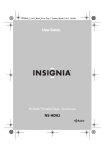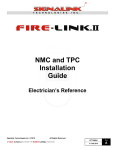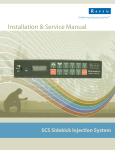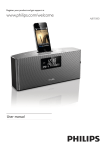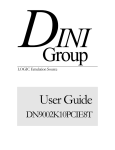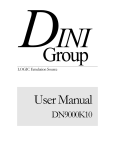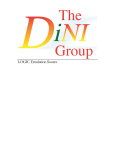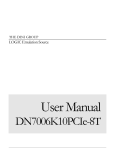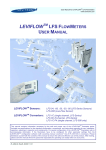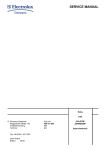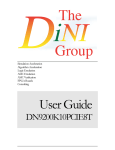Download Transonic®
Transcript
HD02 Repair & Maintenance Manual Transonic Transonic® Flow Q C ® Quality Care HD02 Hemodilaysis Monitor THE INFORMATION HEREIN IS PROPRIETARY. NO PART OF IT MAY BE COPIED OR DISTRIBUTED WITHOUT EXPRESS WRITTEN PERMISSION OF TRANSONIC SYSTEMS INC. MANAGEMENT. USA Technical Support Call # 1-800-353-3569 (USA) AUSHD02 Service Manual Rev. B, 3/04 Copyright 2003 by Transonic Systems Inc. Transonic Systems Inc. Tel: 800-353-3569(USA); Fax 607- 257-7256; www.transonic.com Europe: Tel: 31 43 407 7200; e-mail: [email protected]; Fax: 3143 407 7201 HD02 Maintenance & Repair Manual Contents I. INTRODUCTION page a. Scope of Manual . . . . . . . . . . . . . . . . . . . . . . . . . . . . . . . . . . . . . . . . . . 1 b. Factory Guarantee . . . . . . . . . . . . . . . . . . . . . . . . . . . . . . . . . . . . . . . . . 2 c. Equipment Return Instructions . . . . . . . . . . . . . . . . . . . . . . . . . . . . . . . . 3 II. PERIODIC MAINTENANCE REQUIREMENTS a. Monitor . . . . . . . . . . . . . . . . . . . . . . . . . . . . . . . . . . . . . . . . . . . . . . . . . . 4 b. Flowsensors . . . . . . . . . . . . . . . . . . . . . . . . . . . . . . . . . . . . . . . . . . . . . . 4 c. Record of Sterile Tubing Flowsensor Use . . . . . . . . . . . . . . . . . . . . . . . . 5 III. FLOW MONITOR SPECIFICATIONS . . . . . . . . . . . . . . . . . . . . . . . . . . . 6 IV. TROUBLESHOOTING GUIDE a. Guide . . . . . . . . . . . . . . . . . . . . . . . . . . . . . . . . . . . . . . . . . . . . . . . . . . . 7 b. Replacement Parts . . . . . . . . . . . . . . . . . . . . . . . . . . . . . . . . . . . . . . . . . 8 V. CIRCUIT OPERATION & BLOCK DIAGRAM a. Theory of Operation . . . . . . . . . . . . . . . . . . . . . . . . . . . . . . . . . . . . . . . . 9 b. Circuit Operation & Block Diagrams . . . . . . . . . . . . . . . . . . . . . . . . . . . 11 Transonic Systems Inc. Tel: 800-353-3569(USA); Fax 607- 257-7256; www.transonic.com Europe: Tel: 31 43 407 7200; e-mail: [email protected]; Fax: 3143 407 7201 AUSHD02 Service Manual page i I-a. Introduction 1-a: SCOPE OF THIS MANUAL The intent of this service manual is to teach flowmeter Users and their Biomedical Engineering Service Departments how to maintain HD02 flowmonitor and flowsensor for performance to factory specifications, and how to make elementary repairs, if necessary. Physical care of the flowmeter and flowsensor, including sterilization and cleaning procedures, is also described in the Operator’s Manual. In any instance of equipment malfunction, the User is asked to return the equipment to Transonic Systems Inc. or to its authorized agents for repair or recalibration. CAUTION: SERVICE BY NON-AUTHORIZED PERSONNEL WILL VOID THE FACTORY WARRANTY AND MAY VOID THE SAFETY RATING. Transonic Systems Inc. offers a liberal factory warranty on its flowmeters and flowsensors (see next page). In no event, should the User attempt to modify the flowmeter or flowsensor. Transonic Systems Inc. Tel: 800-353-3569(USA); Fax 607- 257-7256; www.transonic.com Europe: Tel: 31 43 407 7200; e-mail: [email protected]; Fax: 3143 407 7201 AUSHD02 Service Manual page 1 I-b. Factory Guarantee, Service & Warranty A. CALIBRATION GUARANTEE Transonic Systems Inc. certifies that HD02 Hemodialysis Monitor and its software are calibrated by methods traceable to the USA National Institute of Standards and Technology (“NIST”). Transonic Systems Inc. guarantees that the HD02 Flowmeter will stay in calibration during its first year of use, if used and stored per standard clinical apparatus practices. Product users may purchase additional years of recalibration service and certification. B. LIMITED WARRANTY Transonic Systems Inc. warrants for a period of one (1) year from the date of shipment that HD02 Hemodialysis Monitor will remain free from defects which are the result of faulty material or workmanship. Product users may purchase additional years of warranty and repair service insurance. Transonic Systems Inc. warranty shall not apply to: a. defects caused by abuse, neglect or misuse; (e.g., cut cable, pulled cable broken sensor body due to mishandling); b. damage due to accident or casualty; or c. unauthorized repairs, alterations. Transonic Systems Inc. warrants for a period of one (1) year from the date of shipment that H4E sterile tubing sensor will remain free from defects which are the result of faulty material or workmanship. Transonic Systems Inc. will, at no cost to the user, either repair or replace a monitor or sensor found defective within its warranty period. The Buyer pays shipping charges. No other warranty is expressed or implied. Transonic Systems Inc. is not liable for incidental or consequential damages. Warranty is valid only if equipment is purchased through Transonic Systems or its duly appointed distributor or licensed representative. C. WARRANTY CLAIM The obligations of Transonic Systems Inc. under this warranty are limited to repairing or, at its option, replacing any goods determined to be defective. Buyer must notify Transonic Systems Inc. in writing within the warranty period of the reason Buyer believes that warranty repairs are required. Buyer is then required upon the request of Transonic Systems Inc. and at Buyer's expense, to return the goods to the Transonic Systems Inc. manufacturing plant. Freight for shipping the repaired goods from the Transonic Systems Inc. manufacturing plant to Buyer's place of business shall be paid for by the Buyer. Any goods repaired or replaced by Transonic Systems Inc. shall be warranted for the period of time remaining on the original warranty from its date of inception. Transonic Systems Inc. Tel: 800-353-3569(USA); Fax 607- 257-7256; www.transonic.com Europe: Tel: 31 43 407 7200; e-mail: [email protected]; Fax: 3143 407 7201 AUSHD02 Service Manual page 2 I-c. Equipment Return Instructions A. METERS 1. Call Transonic Systems Customer Service (1-800-353-3569) with a description of the problem and the Service Technician will give you a RMA (return material authorization) number. 2. Please use the shipping carton supplied with the meter for returning the meter for repair.If you need a carton, contact Customer Service at 1-800-353-3569. 3. Place the two foam packing pieces over the front and back ends of the flowmeter to protect the meter from damage. Notches in the foam should correspond to the cable exiting the front of the meter. 4. Lift the instrument with its foam padding into the box. 5. On top of the foam, place the cardboard insert along with all correspondence, cables, manuals etc. Seal the box for shipping. 6. With a carrier of your choice, ship the meter back to the factory. The address is: Transonic Systems Inc. 34 Dutch Mill Road. Ithaca, NY 14850, USA 7. B. Direct all questions to Customer Service at @ 800-353-3569 (USA) or fax us @ 607-257- 7256. REUSABLE FLOWSENSORS/PROBES 1. Call Customer Service (1-800-353-3569USA) with a description of the problem and the Service Technician will give you a RMA (return material authorization) number. 2. Thoroughly clean all sensors. Any sensor that has not been cleaned will be immediately returned without repair. 3. Package all parts of the flowsensor in the original packaging along with any correspondence you wish to include. 4. With a carrier of your choice, ship the meter back to the factory. The address is: Transonic Systems Inc. 34 Dutch Mill Road. Ithaca, NY 14850, USA 7. Direct all questions to Customer Service at @ 800-353-3569 (USA) or fax us @ 607-257- 7256. Transonic Systems Inc. Tel: 800-353-3569(USA); Fax 607- 257-7256; www.transonic.com Europe: Tel: 31 43 407 7200; e-mail: [email protected]; Fax: 3143 407 7201 AUSHD02 Service Manual page 3 II. Periodic Maintenance Requirements II-a MONITOR Maintenance Check: A routine maintenance check of the meter consists of exercising all of the functions of the meter with a sampling of flowsensors, and verifying that all features respond as described in the “Functional Tests” section of the Operator’s Manual. If any of these functions do not respond as described, contact Transonic Systems Technical Support Service (1-800-353-3569 USA). Cleaning: Exterior flowmeter surfaces can be cleaned using a cloth or brush dampened with soapy water, followed by damp wiping with clear water. Alternately, the surface can be damp-wiped clean with isopropyl alcohol at room temperature in a dry place. Warning - Do not drip liquids into the meter cabinet. A flowmeter accidently exposed to spillage should be immediately unplugged from its power source. Remove the cover. If the spilled liquid is potentially corrosive or may leave a residue, flood the area with clean water, using care not to disturb components or components. Compressed air may be used to blow liquid off components. Remove the remaining liquid from the unit with a heat gun or a hair dryer. Do not operate the flowmeter in a wet condition. Extreme damage may occur to the unit. II-b FLOW/DILUTION SENSORS Flow/Dilution Sensors: After use of a sterile tubing flowsensor, wash and sterilize the sensor according to the instructions in the Operator’s Manual. If the connector becomes wet, drying overnight in an incubator oven (≤60ºC, 140ºF) is recommended. Transcribe the flow data to the Record of Sensor/Probe Use available in this manual, along with observations of the sensor’s received quality strength. Signal quality usually diminishes as the sensor increases in age. If the received signal quality drops below the 50% level, the sensor should not be used. Inspect the cables and connectors routinely for damage. Store the sensors at room temperature. Transonic Systems Inc. Tel: 800-353-3569(USA); Fax 607- 257-7256; www.transonic.com Europe: Tel: 31 43 407 7200; e-mail: [email protected]; Fax: 3143 407 7201 AUSHD02 Repair Manual, page 4 Record of Flow/Dilution Sensor Use Maintaining a record of sensor received signal quality is part of routine sensor maintenance. The sensor's received signal is normalized to 1.0 at the factory on the tubing for which the sensor is built and should vary only slowly over time (due to transducer “aging”) when the sensor is used with the tubing specified on its Transonic Flowsensor Specifications sheet. As signal degradation may indicate improper mounting of the sensor or deterioration of sensor function, performance tracking is helpful in diagnosing problems before flow readings become questionable. User/contact person _________________________________ phone # _____________________ Sterile-tubing (clamp-on) probe # _____________________ date received ________________ Made for tubing material ______________________________ O.D. ___________ I.D. _________ Date Example Rec’d Signal Amplitude 12/9/97 √ How Used Bench good* In Patient Circuit Notes (Describe tubing if different) ✔ * Good = Signal Quality indicator on meter’s front panel is fully lit. Bench-test procedures are described Section C of this manual. When returning sensors for factory examination, call the factory beforehand for a Return Material Authorization (RMA) number and include this page along with the sensor. Transonic Systems Inc. Tel: 800-353-3569(USA); Fax 607- 257-7256; www.transonic.com Europe: Tel: 31 43 407 7200; e-mail: [email protected]; Fax: 3143 407 7201 AUSHD02 Service Manual page 5 III. HD02 Flow Monitor Specifications HD02 FLOW MONITOR - Ultrasonic transit-time volume flowmeters • • Weight - 10 lbs. Case size 11” wide x 14 “ deep x 4” high (27.8 cm x 35.4 cm x 9.12 cm) General Features • • • • • Automatic sensor recognition and re-scaling of the meter. USB Port High visibility red LED display. Convenient ground connection on rear of unit. Pull cart mounting system available for system mobility. General Specifications • • • • • • Input power - 100-249 VAC 50-60 HZ Detachable medical grade grounded power cord. Fuses - 2 each 1.5A fast-blo 250 VAC 5 x 20 mm. Patient electrical isolation - IEC601 - 1 defibrillation proof @ 5000V. USB Port Agency listed with ETL, CSA, IEC601-1, MDD and CE mark tested and approved. Transonic Systems Inc. Tel: 800-353-3569(USA); Fax 607- 257-7256; www.transonic.com Europe: Tel: 31 43 407 7200; e-mail: [email protected]; Fax: 3143 407 7201 AUSHD02 Service Manual page 6 IV. Troubleshooting Guide Warning: Dangerous voltages are present in the unit when the covers are removed and power is applied. Only Factory Authorized Personnel are permitted to work inside the meter. SYMPTOM WHAT TO CHECK Check the AC power cord Unit will not turn on. The monitor does not measure flow Check the AC fuses in the power entry module CORRECTIVE ACTION Ensure that all power cord connections are fulled seated If blown, replace the TSI P/N TF1A5M5X20 fuses Call Technical Support Service 1-800-353-3569 (USA) HD02 Aquisition does not work Consult the HD02 Operator’s Manual Any other problem Call Technical Support Service 1-800-353-3569 (USA) Transonic Systems Inc. Tel: 800-353-3569(USA); Fax 607- 257-7256; www.transonic.com Europe: Tel: 31 43 407 7200; e-mail: [email protected]; Fax: 3143 407 7201 AUSHD02 Service Manual page 7 IV. Replacement Parts DESCRIPTION 1. 2. 3. 4. 5. 6. 7. 8. 9. 10. 11. 12. TRANSONIC SYSTEMS INC. P/N Sensor holder, HD02 Fuse 1.5A 240 VAC 5mm x 20 mm AC power cord, medical grade, US AC power cord, medical grade, Europe AC power cord, medical grade, UK AC power cord, medical grade, Australia Operator’s Manual, HD02 Standard rolling stand Laptop compatible rolling stand HD02 computer monitor software USB Cable USB Upgrade Kit FEF1003 TF1A5MX20 TPC101-H TPC101-EUR TPC101-UK TPC101-AUS AUTHD02 AOS1000 AOS1002 ASCDHD02 AEUSB-2 AMUSBK-1 Transonic Systems Inc. Tel: 800-353-3569(USA); Fax 607- 257-7256; www.transonic.com Europe: Tel: 31 43 407 7200; e-mail: [email protected]; Fax: 3143 407 7201 AUSHD02 Service Manual page 8 V. Ultrasound Dilution Theory of Operation HD-Series Monitors Use Ultrasound Transit-time Technology to Measure Principle I: Differential Transit-Time Ultrasound Delivered Blood Flow Delivered Blood Flow (flow in the dialysis tubing, pump flow): Ultrasound sensors clipped onto hemodialysis tubing blood lines transmit minute levels of ultrasound through the tubing wall into the blood stream. Sensitive electronics derive flow via transit-time ultrasound principles. Access Flow: After reversing the blood lines, the sensors measure Access Flow by the patented Krivitski Method®. Cardiac Output: With blood lines in their normal position, the Transonic monitor analyzes cardiopulmonary recirculation (CPR) to measure cardiac output. During hemodialysis two matched flow/dilution sensors are clipped onto the arterial and venous dialysis lines (Fig 1). The monitor continuously displays delivered blood flow. Comparison of this reading with the pump flow setting (i.e., the flow the pump tries to deliver) provides an opportunity to identify and correct dialysis delivery problems. HDXX Hemodialysis Monitor A Principle II: b) Patient Dialyzer V Cable Dialysis Tubing The clip-on sensor transmits a beam of ultrasound through the blood line. Two transducers pass ultrasonic Fig. 2: Clip-on signals back and forth, alternately Flow/Dilution Sensor intersecting the flowing blood in upstream and downstream directions. The Hemodialysis Monitor derives an accurate measure of the changes in "transit time" (time it takes for the wave of ultrasound to travel from one transducer to the other) resulting from the motion of the blood in the vessel. The difference between the upstream and downstream transit times is a measure of volume flow. Access Recirculation: Using indicator dilution principles, the same sensors sense the direct reflux of saline from the venous line back into the arterial line after a saline indicator change in the venous blood line. Transonic Flow/Dilution Sensor d) Fig. 1: Transit-time flow/dilution sensing during hemodialysis. System Components a) Hemodialysis Monitor b) Transonic Arterial & Venous Flow/Dilutions Sensors c) Laptop computer for automated calculations d) Isotonic saline (0.9% NaCl) released from the patient’s saline bag or by direct injection into the blood line. Ultrasound Indicator Dilution Patient Blood Flows & Recirculation The velocity of ultrasound in blood (1560-1590 m/sec) is determined primarily by its blood protein concentration. The Transonic® Hemodialysis Monitor and clip-on Flow/dilution Sensors measure ultrasound velocity. A bolus of isotonic saline (ultrasound velocity: 1533 m/sec) introduced into the blood stream dilutes the blood and reduces the ultrasound velocity. The sensor records this saline bolus as a conventional indicator dilution curve. A bolus of saline indicator is introduced into the blood line. As the saline passes through the blood lines, the arterial and venous sensors each register an indicator dilution curve. The following measurements can be selected: Protected under USA patents # 5,453,576; 5,595,182; 5,685,989. International patent #EP 0 781 161 B1 Transonic Systems Inc. Tel: 800-353-3569(USA); Fax 607- 257-7256; www.transonic.com Europe: Tel: 31 43 407 7200; e-mail: [email protected]; Fax: 3143 407 7201 AUSHD02 Service Manual page 9 V. Ultrasound Dilution Theory of Operation Principle II: Ultrasound Indicator Dilution cont. Access Recirculation: the Hemodialysis Monitor identifies the direct reflux of the venous saline indicator bolus into the arterial line (Fig. 3). The ratio of indicator concentrations equals access recirculation. High timing resolution enables identification of zero access recirculation (Fig. 3). Fig. 5: Typical induced recirculation curves for the Krivitski Method®for calculating Qa. Fig. 3: Typical forward-line indicator concentration curves showing 0% access recirculation. Ó Access Flow is measured by the The Krivitski Method®, a pioneering Transonic® contribution to vascular access management (Fig. 4). The upstream (venous) access needle introduces an indicator into the access flow stream. The downstream (arterial) access needle samples the blood concentration diluted by the indicator (Figs. 5). Venous Line Isotonic saline introduction Cardiac Output: with blood lines in the normal configuration and no direct recirculation present, cardiopulmonary recirculation provides a measure of cardiac output (Fig. 6). The full saline indicator bolus travels into the heart where it is mixed (diluted) into the full cardiac output. Part of this diluted indicator then reappears at the Transonic® arterial sensor. Cardiac output and Cardiac Index are calculated via conventional Stewart-Hamilton analysis. Arterial Line Flow/ dilution Sensors Needle Mixing area Qa Fig. 6: Typical forward-line indicator concentration curves cardiac output. Needle Q*a Access Flow Fig. 4: Krivitski Method: Access Flow Measurement. Dialysis lines are reversed to induce recirculation from which vascular access flow (Qa) is calculated. Transonic Systems Inc. Tel: 800-353-3569(USA); Fax 607- 257-7256; www.transonic.com Europe: Tel: 31 43 407 7200; e-mail: [email protected]; Fax: 3143 407 7201 AUSHD02 Service Manual page 10 V. Circuit Operation & Block Diagram Transonic Systems Inc. Tel: 800-353-3569(USA); Fax 607- 257-7256; www.transonic.com Europe: Tel: 31 43 407 7200; e-mail: [email protected]; Fax: 3143 407 7201 AUSHD02 Service Manual page 11 V. Circuit Operation & Block Diagram cont. Transonic Systems Inc. Tel: 800-353-3569(USA); Fax 607- 257-7256; www.transonic.com Europe: Tel: 31 43 407 7200; e-mail: [email protected]; Fax: 3143 407 7201 AUSHD02 Service Manual page 12















